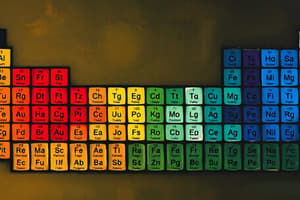Podcast
Questions and Answers
The atomic number of an element is the number of ______ present in the nucleus of an atom.
The atomic number of an element is the number of ______ present in the nucleus of an atom.
protons
Elements with similar properties and electron configurations are placed in the same ______ of the periodic table.
Elements with similar properties and electron configurations are placed in the same ______ of the periodic table.
group
The periodic table is organized by increasing ______ number.
The periodic table is organized by increasing ______ number.
atomic
______ are horizontal rows in the periodic table, with elements in the same period showing similar trends in atomic radius and electron configuration.
______ are horizontal rows in the periodic table, with elements in the same period showing similar trends in atomic radius and electron configuration.
Blocks are horizontal sections of the periodic table, based on the ______ type of the last electron added.
Blocks are horizontal sections of the periodic table, based on the ______ type of the last electron added.
Elements on the left side and center of the periodic table are classified as ______.
Elements on the left side and center of the periodic table are classified as ______.
Flashcards are hidden until you start studying
Study Notes
Atomic Number and the Periodic Table
Definition of Atomic Number
- The atomic number of an element is the number of protons present in the nucleus of an atom.
- It is a unique identifier for each element and determines the position of an element in the periodic table.
Organization of the Periodic Table
- The periodic table is organized by increasing atomic number (number of protons in the nucleus).
- Elements with similar properties and electron configurations are placed in the same group (column) of the periodic table.
Periods and Groups in the Periodic Table
- Periods: horizontal rows in the periodic table, with elements in the same period showing similar trends in atomic radius and electron configuration.
- Groups: vertical columns in the periodic table, with elements in the same group showing similar chemical properties due to the same number of electrons in their outermost energy level.
Blocks in the Periodic Table
- Blocks are horizontal sections of the periodic table, based on the orbital type of the last electron added (s, p, d, or f).
- Blocks help to identify elements with similar electron configurations and chemical properties.
Metals, Nonmetals, and Metalloids
- Metals: elements on the left side and center of the periodic table, tend to lose electrons to form cations.
- Nonmetals: elements on the right side of the periodic table, tend to gain electrons to form anions.
- Metalloids: elements on the border between metals and nonmetals, exhibit intermediate properties.
Studying That Suits You
Use AI to generate personalized quizzes and flashcards to suit your learning preferences.




